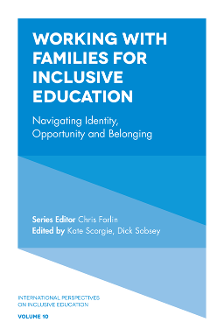
Index
Working with Families for Inclusive Education
ISBN: 978-1-78714-261-9, eISBN: 978-1-78714-260-2
ISSN: 1479-3636
Publication date: 13 May 2017
Citation
(2017), "Index", Working with Families for Inclusive Education (International Perspectives on Inclusive Education, Vol. 10), Emerald Publishing Limited, Leeds, pp. 281-284. https://doi.org/10.1108/S1479-363620170000010027
Publisher
:Emerald Publishing Limited
Copyright © 2017 Emerald Publishing Limited
INDEX
- Prelims
- Section I Personal and Family Perspectives on Inclusion: Navigating Identity, Opportunity, and Belonging
- Ability and Opportunity in the Rearview Mirror
- “I Could have so Easily been Excluded”: Exploring Narratives of Inclusion and Exclusion in the Lives of Professional Performers with Disabilities
- A Game of Give and Take: My Journey Through Special Education and Inclusion
- The Ecocultural Project of Family Life
- The Gift of Belonging: From Parents to Society
- Parental Perspective about Inclusive Education in the Pacific
- An Emancipatory Stance Regarding Fathers of Children with Disabilities
- Broadening Family Perspectives: The Experiences of Fathers and Siblings When a Child Has Chronic Illness or Disability
- My Special Sister
- Section II Fostering Collaborative Partnerships for Inclusion: Frameworks and Strategies
- “Diagnosing” the Need or in “Need” of a Diagnosis? Reconceptualizing Educational Need
- Father and Son
- Hidden Voices: Parents’ Perspectives on the Barriers to and Facilitators of Inclusion on Their Preschool Children with Disabilities
- 40 Years of Inclusive Education Advocacy: A Personal Perspective
- Toward a Vision of Inclusive Learning Communities: It Takes the Village
- Rethinking Individual Education Plans: Searching for a Better Way
- Engaging Parent Strengths for Inclusion: The Power of Optimism, Hope, and Courage
- Being a Parent and a Teacher: Personal Reflections
- Transition Post-School: Five Steps Toward Reducing the Hurdles
- Conclusion
- So You Think We Can Trust? (Re)building Home-School Collaboration with Families of Children with Disability
- About the Authors
- Index